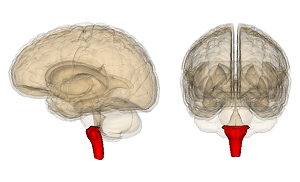Autonomic Nervous System
 The autonomic nervous system is included in the peripheral system and is largely unconscious. It controls vital body functions such as heart rate, swallowing, breathing, digestion, and arousal. Although primarily unconscious, many aspects of the autonomic nervous system can come under conscious control. For example, people can choose to hold their breath or swallow rapidly. When people do not actively choose to control these functions, however, the autonomic nervous system takes over and controls them. Some portions of the system, however, are not under conscious control. For example, people cannot choose to alter their heart rate or blood pressure.
The autonomic nervous system is included in the peripheral system and is largely unconscious. It controls vital body functions such as heart rate, swallowing, breathing, digestion, and arousal. Although primarily unconscious, many aspects of the autonomic nervous system can come under conscious control. For example, people can choose to hold their breath or swallow rapidly. When people do not actively choose to control these functions, however, the autonomic nervous system takes over and controls them. Some portions of the system, however, are not under conscious control. For example, people cannot choose to alter their heart rate or blood pressure.
Autonomic Nervous System Components
The autonomic nervous system is regulated in an area called the medulla oblongata which is a part of the lower brainstem.
The autonomic nervous system can be further broken down into two sub-systems:
- The sympathetic nervous system – The sympathetic nervous system often acts as a mobilizing agent that prepares the body for action by engaging in functions such as elevating heart rate and increasing respiration.
- The parasympathetic nervous system – The parasympathetic nervous system acts as a counter to this function, by slowing down the body after a period of activity. However, these two systems also work together in many capacities; for example, both play a role in sexual orgasm.
Autonomic Nervous System and Psychology
While the autonomic nervous system is only partially under conscious control, psychological states can affect the system. Chronic stress can lead to elevated heart rates, increased blood pressure, dilated pupils, and other symptoms of increased arousal. Psychotherapy that reduces stress, then, can affect the autonomic nervous system and may improve overall health.
Some psychoactive drugs can also affect the functions of the autonomic nervous system. Amphetamines, which are commonly prescribed to treat ADHD, can lead to elevated heart rates and increased arousal.
References:
- American Psychological Association. APA concise dictionary of psychology. Washington, DC: American Psychological Association, 2009. Print.
- Audesirk, T., Audesirk, G., & Byers, B. E. (2008). Biology: Life on earth with physiology. Upper Saddle River, NJ: Pearson Prentice Hall.
Last Updated: 08-4-2015
- 2 comments
- Leave a Comment
Roger D.
September 13th, 2018 at 5:01 AMUseful information
wjh
March 28th, 2020 at 11:26 PMHow is the vagus nerve involved in or how does it interact in the autonomic nervous system?
Leave a Comment
By commenting you acknowledge acceptance of GoodTherapy.org's Terms and Conditions of Use.

